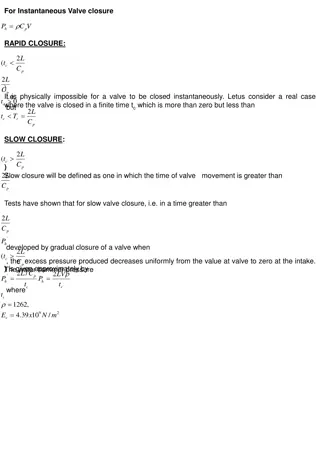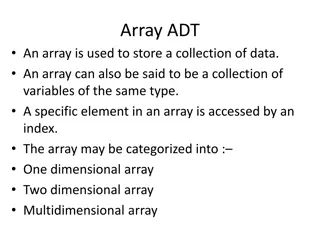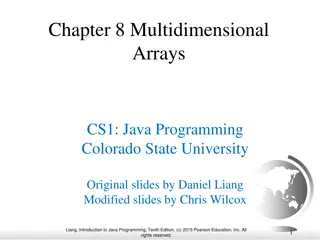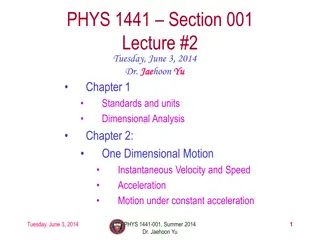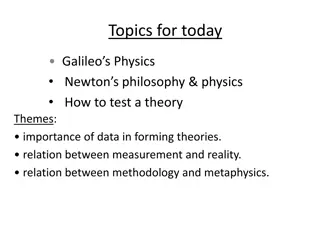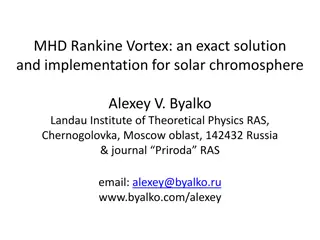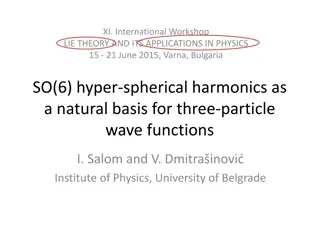Understanding Dimensional Analysis in Physics
Dimensional analysis in physics involves defining dimensions of physical quantities, determining dimensionless quantities, checking dimensional consistency of equations, converting units, and exploring the limitations and applications of dimensional analysis. By understanding dimensions and dimensional formulas, relationships among physical quantities can be deduced and equations can be verified for dimensional correctness.
Download Presentation

Please find below an Image/Link to download the presentation.
The content on the website is provided AS IS for your information and personal use only. It may not be sold, licensed, or shared on other websites without obtaining consent from the author. Download presentation by click this link. If you encounter any issues during the download, it is possible that the publisher has removed the file from their server.
E N D
Presentation Transcript
Contents : Dimension and its definition & dimensionless quantities. Some important dimensional formulas. Checking the Dimensional Consistency of Equations. Deducing Relation among the Physical Quantities. To convert any physical quantity from one unit system to another system. Limitations of Dimensional Analysis.
Dimension: The dimensions of a physical quantity are the powers to which the fundamental quantities are raised to represent that physical quantity. They are represented by square brackets around the quantity. The expression which shows how and which of the base quantities represent the dimensions of a physical quantity is called the dimensional formula of the given physical quantity. An equation obtained by equating a physical quantity with its dimensional formula is called the dimensional equation of the physical quantity.
Dimensions of the 7 base quantities are Length [L], Mass [M], time [T], electric current [A], thermodynamic temperature [K], luminous intensity [cd] and amount of substance [mol]. Let any physical quantity A ,depends mass, length ,time with powers a,b,& c then : Dimensional Formula : [MaLbTc] Dimensional equation : [A]= [MaLbTc] For example, the dimensional equations of volume [V], speed [v], force [F ] and mass density [ ] may be expressed as: [V] = [M0 L3 T0] [v] = [M0 L T 1] [F] = [M L T 2] [ ] = [M L 3 T0]
Dimensionless Quantities: The arguments of special functions, such as the trigonometric, logarithmic and exponential functions are dimensionless. A pure number is always dimensionless. ratio of similar physical quantities, such as angle as the ratio (length/length), refractive index as the ratio (speed of light in vacuum/speed of light in medium) etc., has no dimensions. Plane angle and solid angles are dimensionless. Dimensionless Constants:Such constants which do not have dimensions are called as dimensionless constants. For ex. Refractive Index , relative density, velocity of light in vacuum etc. Dimensional constants: Such constants which have dimensions are called as dimensional constants. For ex. Universal gravitational constant, electric permittivity, Coefficient of elasticity etc.
Applications of Dimensional Analysis
Only those physical quantities which have same dimensions can be added and subtracted. This is called principle of homogeneity of dimensions. According to this principle of homogeneity a physical equation will be dimensionally correct if the dimensions of all the terms occurring on both sides of the equation are the same.
Example: Let us consider an equation where m is the mass of the body, v its velocity, g is the acceleration due to gravity and h is the height. Check whether this equation is dimensionally correct. The dimensions of LHS are: [M] [L T 1 ]2 = [M] [ L2 T 2] = [M L2 T 2] The dimensions of RHS are: [M][L T 2] [L] = [M][L2 T 2] = [M L2 T 2] The dimensions of LHS and RHS are the same and Hence the equation is dimensionally correct.
To deduce relation among physical quantities, we should know the dependence of one quantity over others (or independent variables) and consider it as product type of dependence. Dimensionless constants cannot be obtained using this method.
Deducing Relation among the Physical Quantities: Example: Consider a simple pendulum, having a bob attached to a string, that oscillates under the action of the force of gravity. Suppose that the period of oscillation of the simple pendulum depends on its length (l), mass of the bob (m) and acceleration due to gravity (g). Derive the expression for its time period using method of dimensions. The dependence of time period T on the quantities l, g and m as a product may be written as: T = k lx gy mz where k is dimensionless constant and x, y and z are the exponents.By considering dimensions on both sides, wehave [LoMoT1]= [L]x[L1 T 2 ]y[M1 ]z = Lx+yT 2yMz On equating the dimensions on both sides, we have x + y = 0; 2y = 1; and z = 0 So that x=1/2 y =-1/2 z=0 Then, T = k l g T=k l/g
If we want to convert a physical quantity from one unit system to another system, we can easily do that with the help of dimensional analysis. A physical quantity has two parts; one is the numerical or magnitude part and the other part is the unit part. Suppose there s a physical quantity X, which has unit U and magnitude N , then its magnitude is inversely proportional to unit system it will be expressed as: X = NU To convert a physical quantity from one unit to another we use below relation: N1U1= N2U2 .(1) Where N1and N2are numerical parts and U1and U2are dimensions or units of both quantities. U1 = [Ma1 Lb1 Tc1] U2 = [Ma2 Lb2 Tc2] . .(2) Using (1) & (2) N1 [Ma1 Lb1 Tc1] = N2[Ma2 Lb2 Tc2] If N1 is known then magnitude N2 can be calculated using this relation
Dimensional analysis has no information on dimensionless constants. If a quantity is dependent on trigonometric or exponential functions, this method cannot be used. In some cases, it is difficult to guess the factors while deriving the relation connecting two or more physical quantities. This method cannot be used in an equation containing two or more variables with same dimensions. It cannot be used if the physical quantity is dependent on more than three unknown variables. This method cannot be used if the physical quantity contains more than one term, say sum or difference of two terms.
By: Govind Sharma PGT (Physics) AECS 4, Rawatbhata


